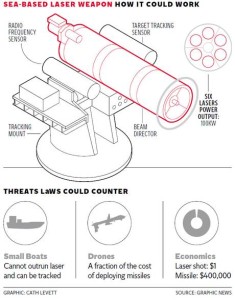Star Wars to Become Reality as US Navy on Course to Arm Ship with Laser
MILITARISM, 24 Feb 2014
Some of the US Navy’s futuristic weapons sound like something out of Star Wars, with lasers designed to shoot down aerial drones and electric guns that fire projectiles at hypersonic speeds.
The Navy plans to deploy its first laser on a ship later this year, and it intends to test an electromagnetic rail gun prototype aboard a vessel within two years.
For the Navy, it’s not so much about the whizz-bang technology as it is about the economics. Both are cheap compared with missiles and smart bombs, and they can be fired continuously.
“It fundamentally changes the way we fight,” said Captain Mike Ziv, programme manager for directed energy and electric weapon systems for the Naval Sea Systems Command. The Navy’s laser technology has evolved to the point where a prototype to be deployed aboard the USS Ponce this summer can be operated by a single sailor, he said.
The solid-state laser weapon system is designed to target “asymmetrical threats”. These include aerial drones, speedboats and swarm boats, all threats to warships in the Persian Gulf, where the Ponce, a staging base, will be deployed.
Rail guns fire a projectile at six or seven times the speed of sound – enough velocity to cause severe damage. The Navy sees them as replacing or supplementing old-school guns.
But both systems have shortcomings. Lasers tend to lose their effectiveness if it’s raining, dusty, or if there is turbulence in the atmosphere, and the rail gun requires vast amounts of electricity to launch the projectile.
Producing enough energy for a rail gun is another problem. The Navy’s new destroyer, the Zumwalt is the only ship with enough electric power to run one. The stealth ship’s gas turbine-powered generators can produce up to 78 megawatts – enough electricity for a medium-sized city.
The Navy’s laser directs a beam of energy that can burn through a target or fry sensitive electronics.
The targeting system locks on to the target, sending a beam of searing heat. “You see the effect on what you are targeting, but you don’t see the actual beam,” Capt Ziv said.
Other countries are developing their own lasers, but the US Navy is more advanced at this point.
“It’s fair to say there are other countries working on this technology,” Capt Ziv said.
“I would also say that a lot of what makes this successful came from the way in which we consolidated all of the complexity into something that can be operated by [a single sailor],” he said.
AP
Go to Original – independent.co.uk
DISCLAIMER: The statements, views and opinions expressed in pieces republished here are solely those of the authors and do not necessarily represent those of TMS. In accordance with title 17 U.S.C. section 107, this material is distributed without profit to those who have expressed a prior interest in receiving the included information for research and educational purposes. TMS has no affiliation whatsoever with the originator of this article nor is TMS endorsed or sponsored by the originator. “GO TO ORIGINAL” links are provided as a convenience to our readers and allow for verification of authenticity. However, as originating pages are often updated by their originating host sites, the versions posted may not match the versions our readers view when clicking the “GO TO ORIGINAL” links. This site contains copyrighted material the use of which has not always been specifically authorized by the copyright owner. We are making such material available in our efforts to advance understanding of environmental, political, human rights, economic, democracy, scientific, and social justice issues, etc. We believe this constitutes a ‘fair use’ of any such copyrighted material as provided for in section 107 of the US Copyright Law. In accordance with Title 17 U.S.C. Section 107, the material on this site is distributed without profit to those who have expressed a prior interest in receiving the included information for research and educational purposes. For more information go to: http://www.law.cornell.edu/uscode/17/107.shtml. If you wish to use copyrighted material from this site for purposes of your own that go beyond ‘fair use’, you must obtain permission from the copyright owner.
